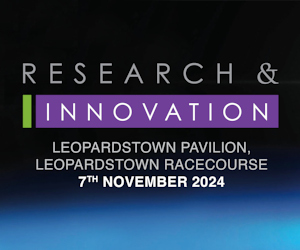Energy-efficient aeration solutions for waste water treatment

UCD spinout OxyMem is commercialising its breakthrough technology to address the global need for a more energy-efficient aeration solution for wastewater treatment, writes Adam Shanley.
A century has passed since the introduction of the activated sludge process and this year saw many conferences to celebrate this occasion. Over the years, the process has undergone numerous revisions and variations to achieve higher and higher discharge standards, including ammonia and phosphorous removal. Today, activated sludge still remains the most widely used process for biological waste water treatment. Despite small innovations, the core principle remains the same – the aeration of (sludge) biomass to degrade dissolved pollutants.
Aeration of waste water consumes over 1 per cent of a developed nation’s electricity. However, despite many different forms of aeration existing (such as coarse bubble, jet, fine bubble and surface aeration), only 30 per cent of the oxygen supplied to the processes is available for the aerobic biomass, resulting in 70 per cent wastage. Energy requirements for the supply of oxygen vary from 0.5 kgO2/kWhr for surface aerators to over 2kgO2/Kwhr for fine bubble diffusers.
All of the current aeration processes rely on bubbles or gas to liquid oxygen transfer, with the dissolved oxygen then being available for the biomass. The membrane-aerated biofilm reactor (MABR) transfers the oxygen required for aerobic biological degradation process through a gas-permeable membrane directly to the biomass, which grow as a biofilm on the membrane surface.
This means that the oxygen does not have to be dissolved in the bulk liquid and, because the air inside the membranes is not subject to buoyancy forces in the same way as a bubble, is much higher. Oxygen transfer efficiencies (OTE) of over 80 per cent can be achieved. Additionally, because the supplied air does not have to overcome the hydrostatic head in the tank, much lower air pressures can be used to supply air. Both of these factors combine to result in a significant energy saving for waste water aeration, with up to 8kgO2/kWh being achievable.
Research into the MABR has been carried out in the labs of Prof Eoin Casey in University College Dublin’s School of Chemical and Bioprocess Engineering for over 10 years, leading to a deeper understanding of both the biological and mass transfer process which form the underlying operating principles.
The accumulation of this research led to the establishment of OxyMem Ltd, a spinout from UCD which provides the world’s first full-scale MABR for industrial and municipal waste water treatment. The OxyMem (MABR) is a revolutionary new technology which is set to disrupt the way the world deals with its waste water treatment.
The OxyMem technology
 Following pre and/or primary treatment, waste water passes to the OxyMem MABR for treatment of the dissolved pollutants. The OxyMem system can be configured as a complete standalone secondary waste water treatment processes or alternatively, because of the compact nature of the system and the ability to deploy the technology as a package plant, it can be installed to give additional capacity to a plant that is currently overloaded. This can be done by dividing the flow between a current existing system and an OxyMem unit or by placing OxyMem at the end of the current treatment process to provide a polishing stage.
Following pre and/or primary treatment, waste water passes to the OxyMem MABR for treatment of the dissolved pollutants. The OxyMem system can be configured as a complete standalone secondary waste water treatment processes or alternatively, because of the compact nature of the system and the ability to deploy the technology as a package plant, it can be installed to give additional capacity to a plant that is currently overloaded. This can be done by dividing the flow between a current existing system and an OxyMem unit or by placing OxyMem at the end of the current treatment process to provide a polishing stage.
Along with the aeration energy savings, as a result of the unique ecosystem created by the micro-organisms growing together in a biofilm, there are a number of associated benefits with the operation of the OxyMem MABR.
The system is highly resilient to changes in influent composition and flow rate. In severe cases, where industrial and municipal inflow quality changes unpredictably because the biomass grows as a biofilm, it is not washed or killed as can occur in suspended growth systems requiring a 6-8 week reseeding process.
The biofilm which form on the surface of OxyMem’s membranes is also unique in its population profile, because the oxygen and pollutants diffuse from opposite sides of the biofilm. The slow-growing, ammonia-oxidising microbes grow close to the membrane surface where there are protected from sloughing. It also means that the bulk liquid can remain anoxic while at the same time maintaining an aerobic biofilm. This allows for multiple processes in one tank and removes the requirement to recirculate large quantities of water.
Dr Eoin Syron is the OxyMem MABR technical director and co-founder of OxyMem. He studied under Prof Casey and is confident that the technology is set to overtake traditional aeration systems as the gold standard.
“The energy positive waste water treatment plant can exist today and while anaerobic treatment can produce energy, aerobic treatment is still required to produce water clean enough to discharge to the environment,” he explained. “OxyMem minimises the energy required for aerobic treatment, allowing the maximum use of the produced energy.”
OxyMem is among the Top 30 companies shortlisted for the Global Cleantech Cluster Association (GCCA) 2014 Later Stage Awards. The prestigious shortlist consists of mid- to late-stage companies that originate from a variety of cleantech industries and have a proven track record in their home market, with the goal to expand internationally. Winners in the 10 Later Stage Award categories, plus one Grand Prize winner, will be announced at the 5th annual Cleantech Investing Seminar to be held in Lausanne, Switzerland on 3 December 2014.








There are no comments at the moment, do you want to add one?
Write a comment